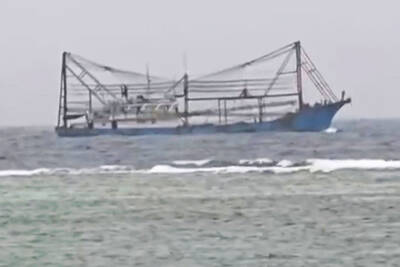Data gathered by the Formosat-7/COSMIC-2 satellite constellation are to be released for global use today, Taiwanese and US officials announced yesterday.
The six-satellite constellation, which gathers weather data between 50° north and south latitude, was launched into orbit on June 25 last year, another major Taiwan-US collaborative program following the Formosat-3/COSMIC constellation launched in 2006.
After nearly three months of trials, Formosat-7 data are to be released by the Central Weather Bureau (CWB) and the US National Oceanic and Atmospheric Administration (NOAA) simultaneously at 10am, National Applied Research Laboratories (NARL) president Wang Yeong-her (王永和) told a news conference at the Ministry of Science and Technology in Taipei.

Photo: Chien Hui-ju, Taipei Times
Data would be released from the previous day, the NARL said, adding that hopefully, near-real-time data would be available later.
In addition to improving forecasts, the data would advance projections of space weather events that can affect the precision of information and communication facilities, Wang said.
The satellite program showcases what can be achieved through Taiwan-US science and technology cooperation, proving that the two sides are “real friends” making “real progress,” American Institute in Taiwan Deputy Director Raymond Greene said in Mandarin.
“Wherever I go, I tell people that Taiwan is a leader in many fields and has much to offer the world,” Greene said.
“This satellite mission proves this is true,” he said, adding that he is confident the world would continue to benefit from ongoing Taiwan-US scientific cooperation.
The data would supplement observation data in the tropics, where installing facilities is challenging, given the paucity of land there, CWB Deputy Director-General Mark Cheng (程家平) said.
After using data from the satellites to track 10 typhoons in the Western Pacific last year, the bureau found that 120-hour forecast precision improved 7 percent, Cheng said.
The Formosat-7 program is highly valued worldwide because data can be made available in 30 minutes to one hour, whereas Formosat-3 needed three hours, National Cheng Kung University professor of Earth science Charles Lin (林建宏) said.
Space weather forecasts are receiving mounting attention with the development of autonomous vehicles, which use GPS, Lin said.
The atmospheric data gathered by the Tri-GNSS Radio Occultation System, which was part of each Formosat-7 satellite’s payload, would be available first, said National Space Organization (NSPO) member Chu Chung-hui (朱崇惠), the head of the Formosat-7 project in Taiwan.
Data gathered by the project’s ion velocity meter and radio frequency beacon instruments are being verified and would be made available later, Chu said.
While only two of the six satellites have settled from their injection orbits at an altitude of 720km into their planned orbits of 550km, the project has peaked at 5,802 data packets in a day, surpassing estimates that it would be capable of 4,000 per day, she said.
The four satellites not in the planned orbits are expected to settle in them by February next year, although they can gather data in the meantime, she said.
There are 10 ground stations — in Taiwan; Guam; Hawaii; Darwin, Australia; Mauritius; Kuwait; Ghana; Cuiaba, Brazil; Honduras; and Tahiti — that can receive Formosat-7 data, the NSPO said.
Asked about the next Taiwan-US space program, NSPO Director-General Lin Chun-liang (林俊良) said that the nation plans to develop high-resolution remote-sensing satellites and synthetic aperture radars in its third space program through 2028, while it hopes to learn from the US and other nations about space exploration that requires advanced telecommunications.

A Chinese aircraft carrier group entered Japan’s economic waters over the weekend, before exiting to conduct drills involving fighter jets, the Japanese Ministry of Defense said yesterday. The Liaoning aircraft carrier, two missile destroyers and one fast combat supply ship sailed about 300km southwest of Japan’s easternmost island of Minamitori on Saturday, a ministry statement said. It was the first time a Chinese aircraft carrier had entered that part of Japan’s exclusive economic zone (EEZ), a ministry spokesman said. “We think the Chinese military is trying to improve its operational capability and ability to conduct operations in distant areas,” the spokesman said. China’s growing

Nine retired generals from Taiwan, Japan and the US have been invited to participate in a tabletop exercise hosted by the Taipei School of Economics and Political Science Foundation tomorrow and Wednesday that simulates a potential Chinese invasion of Taiwan in 2030, the foundation said yesterday. The five retired Taiwanese generals would include retired admiral Lee Hsi-min (李喜明), joined by retired US Navy admiral Michael Mullen and former chief of staff of the Japan Self-Defense Forces general Shigeru Iwasaki, it said. The simulation aims to offer strategic insights into regional security and peace in the Taiwan Strait, it added. Foundation chair Huang Huang-hsiung

PUBLIC WARNING: The two students had been tricked into going to Hong Kong for a ‘high-paying’ job, which sent them to a scam center in Cambodia Police warned the public not to trust job advertisements touting high pay abroad following the return of two college students over the weekend who had been trafficked and forced to work at a cyberscam center in Cambodia. The two victims, surnamed Lee (李), 18, and Lin (林), 19, were interviewed by police after landing in Taiwan on Saturday. Taichung’s Chingshui Police Precinct said in a statement yesterday that the two students are good friends, and Lin had suspended her studies after seeing the ad promising good pay to work in Hong Kong. Lee’s grandfather on Thursday reported to police that Lee had sent

A Chinese ship ran aground in stormy weather in shallow waters off a Philippines-controlled island in the disputed South China Sea, prompting Filipino forces to go on alert, Philippine military officials said yesterday. When Philippine forces assessed that the Chinese fishing vessel appeared to have run aground in the shallows east of Thitu Island (Jhongye Island, 中業島) on Saturday due to bad weather, Philippine military and coast guard personnel deployed to provide help, but later saw that the ship had been extricated, Philippine navy regional spokesperson Ellaine Rose Collado said. No other details were immediately available, including if there were injuries among